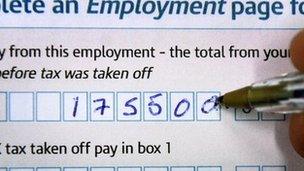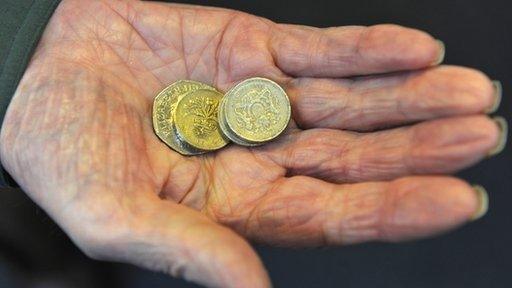Scottish independence: Fairer shares of income
- Published

In 2009, the top earning 1% in Scotland earned 9.4% of the total pay bill
Globalisation is one of the main culprits for the rise in inequality of income. Those with rare skills, such as superstar chief executives and footballers, can compete for jobs internationally.
Those with fewer and all-too-common skills find they're up against distant workers with much lower wage expectations. If you have rare skills, your pay goes up. If you do have few skills, your pay is undercut - if you keep your job at all.
That helps explain why income inequality has been growing in recent decades. In Britain, it grew fastest with the clear-out of old industries and the reduced power of trade unions.
In the early years of this century, income inequality grew faster in other, similar countries. But the British figure was increasingly skewed by the humongous pay of business executives, financiers and the international super-rich who found London an agreeable place to base themselves.
By 2010, of 34 states, the UK was seventh most unequal, behind Chile, Mexico, Turkey, the US, Israel and Portugal. It's even more unequal if you only look at the working age population.
Scotland was midway down the table - with less inequality than Italy, New Zealand and South Korea, and more than Poland, France and Switzerland. In 2009, the top earning 1% in Scotland earned 9.4% of the total pay bill, up from 6.3% of pre-tax incomes in 1997.
And the country is likely to become more unequal while the government at Westminster opts to target big cuts in welfare. If you leave taxation steady, that means less being done to redistribute income.
Hindered growth
The inequality within the economy is confronted in the Scottish government's white paper on independence: "Scotland is currently part of a UK economic model and society which is one of the most unequal in the OECD (the establishment club of better off countries).
"Inequality within the UK has increased in recent decades. Such patterns of inequality will continue to have a negative impact on growth and prosperity over the long term".
The implication is that inequality is bad, it hinders growth, and it should be reduced. The explicit pledge is to use the levers of power, if Scotland votes for independence, to tackle it.
While it may well be unfair, its impact on the economy is contestable. Even if you could prove that more equal distribution of income from Britain's or Scotland's current state could improve both growth and well-being - and you may well be able to - that is unlikely to be true at every level of distribution. At some point, reducing inequality can be expected to cease having a positive effect on growth, perhaps where it leaves little or no incentive to raise one's income.
And all this, remember, is not about the distribution of wealth within the economy. Perhaps due to Britain's obsessions with investing in bricks and mortar, allied to one of the less bad private pension systems, Britain's middle class have ensured the nation is closer to the middle of the league table on wealth distribution.
Upskilled workforce
But on income, Stirling University academics have done some suitably pointy-headed analysis of how much Scotland can now alter the distribution, and how much it could do so after independence with a mix of tax increases and welfare changes. The answers are, in brief: a) not much and b) a bit more, but not much more.

The report looked at what difference tax increases and welfare changes could make
The complication they identify is how people respond to higher taxes or changes in welfare payments. They have to make assumptions about behaviour, so remember that modelling can, and probably will, get it wrong. But on tax, the findings are striking.
If the top rate of tax went up by only one penny per pound earned, it looks like it could raise £40m. Until, that is, people respond by working less or taking themselves off to a lower tax regime - the rest of the UK, for instance. That way, the £40m gain is reduced to only £2m.
That's not much good for public spending, while it has very little effect on reducing inequality. It only closes 1% of the gap between Scotland and its northern European neighbours.
So if Scotland wants to look more Scandanavian in income distribution, surely it could raise welfare payments? Well, a 10% increase in Jobseekers Allowance, according to the Stirling economists, only goes 3% of the distance towards closing the gap between Scottish and Nordic inequality.
The conclusion is that if we want to look like Scandanavians, in terms of income distribution, we would have to do a lot more than they do to compensate for the inequalities within pay rates set by the market.
That's not to say the levers don't exist. But this work does suggest they may not be where the white paper is looking. It may require a more radical approach to reforming the labour market. The easy option would be to raise the minimum wage, perhaps to the living wage level.
Over the longer term, you could aim to upskill the workforce and ensure through domestic and inward investment policies that a higher quality of higher-paid job is available. You ought to be aware, though, that you're not alone in trying to do that. Every country is.
- Published21 January 2014
